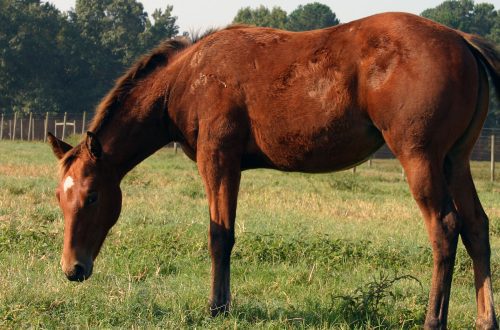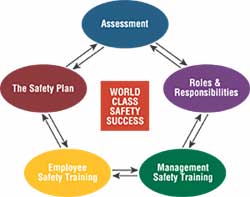
The Five Stages of Training: The Basics of Safe Training
The Five Stages of Training: The Basics of Safe Training
Whether you’re an equestrian or just a hobby, your horse will benefit if you plan your workouts with his physiology in mind. Each lesson should be divided into several stages, taking place in a logical sequence.
As a rule, workouts are structured as follows: preparation, warm-up, main part, stepping back and post-workout procedures.
The amount of time given to each phase depends on the intensity of the training, but remember that all your decisions must be made on the basis of the principle of “do no harm”. This will reduce the risk of injury and improve your horse’s performance.
Preparing for a workout
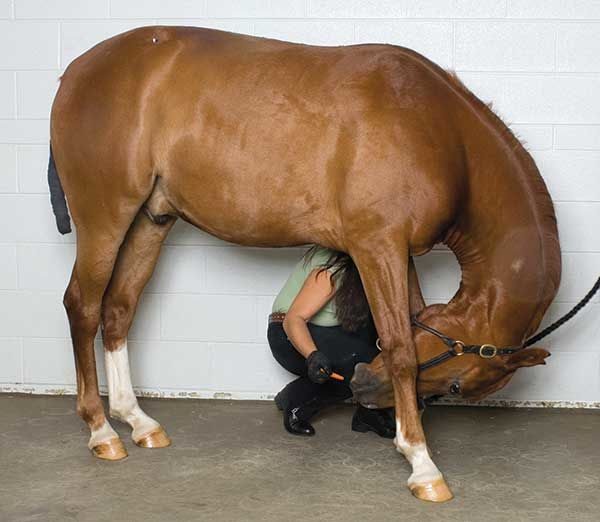
Preparation for training includes cleaning and saddle, as well as some exercises that activate the muscles before starting the workout.
Stretching. Cut the carrots into slices about 1 cm thick. You will need these as “bait” to encourage the horse to pull upside down with his head and neck. Be careful that the horse does not grab you by the fingers.
Stand the horse against a wall or have someone help hold it. Thus the horse will not move, but stretch. Ask the horse to reach to the chest, down to the hooves, to the girth area, to the groin, to the hock and between the front legs (see photo). Wait a couple of seconds before giving the carrot, then let the horse relax. Repeat the stretch. Gradually ask the horse to stretch more and more.
As a rule, stretching exercises are not performed until the horse has warmed up the muscles. However, the “carrot” stretch is safe: the horse stretches on its own and voluntarily, without leaving its comfort zone.
The goal of the exercise is to get the horse to pull harder without losing balance. Even without maximum stretch, these exercises are useful for activating the muscles that support the spine. It is recommended to stretch three times in each direction. Lateral stretching is performed both to the left and to the right.
During stretching, the muscles that support the skeleton of the neck and back are activated. This prevents slight friction between the vertebrae, which can later lead to arthritis.
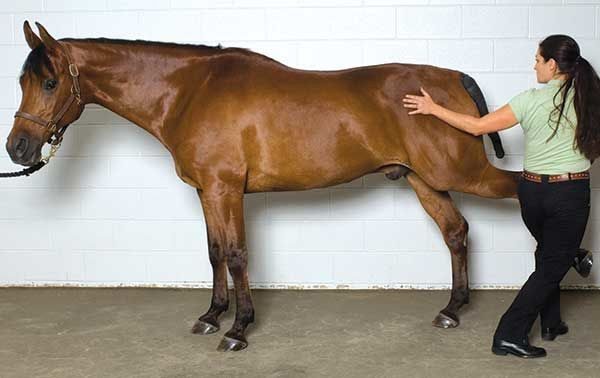
Hind leg stretch horses. This is a passive exercise in which you extend the horse’s hind legs back. You need to stretch in such a way that the thigh opens at the joint. This stretches the lumbar muscles. When doing this exercise, remember about your own safety. Run it as shown in the photo. Stop whenever you encounter resistance. Hold the most extended position for 30 seconds. Then slowly lower the horse’s leg to the ground.
The second stage of horse training is warm upwhich is arguably the most important part of the whole process. At the moment, there is more and more discussion about which exercises are most beneficial for horses. The basic principle is that you start with a walk, then work in large circles, gradually increasing the load and intensity over 10-15 minutes. The duration and composition of the warm-up depends on the particular horse (age, injuries, work features), weather, and the goals of the upcoming training.
Horses that spend most of their time standing in a stall need longer walks and a more gradual warm-up. muscles than horses that have been walking in the levada all day. Also, horses with osteoarthritis need a longer and more measured warm-up. Keep in mind that in cold weather, when walking for a long time, the horse may freeze – use a half-cloth.
Since when trotting and cantering exercises are included in the work, the number of heart contractions increases, and blood circulation. The distribution of blood changes, more blood goes to the muscles. The intensity of breathing increases – more oxygen enters the lungs. In this regard, it is necessary to gradually increase the intensity of exercises. Horse muscles produce heat. The body temperature of the horse rises during training by 1-2 degrees. This increase in temperature improves the elasticity of the ligaments and tendons and allows the muscles to contract more intensely. The horse needs to be given a few minutes to trot or canter in order for the temperature to change. Although most of the changes that occur in a horse during a warm-up are similar to those that occur in a human body in a similar situation, the main difference is that the spleen of a horse during intense exercise releases a certain amount of red blood cells stored in it into the bloodstream during intense exercise. The extra red blood cells increase the amount of oxygen carried in the blood and help reduce lactic acid production. So if you’re planning an intense workout, it’s important that those extra red blood cells are released. Even a small reprise of the gallop will suffice.
The following exercises may be included in the warm-up: work on the lunge, work in the hands, work under the saddle.
If you start from work nothing, let your horse the first five minutes will freely walk in a circle of a large radius before you ask her for active movements.
Of course, a horse that has been standing in a stall all day has a lot of energy that it will want to release, so not every animal will be able to achieve a calm step from every animal. If you know your horse will lunge, it’s best to walk him in your arms. Walking in your hands before lunging will help your horse warm up his joints and prepare his musculoskeletal system for more vigorous exercise.
If you started from work under saddle, the principle is the same. Start by walking on a long rein: let the horse stretch its neck forward and down. After 5-10 minutes, pick up the reins and walk with tighter contact, pick up the horse. Gradually increase the intensity of your workout. Engage in a trot or gallop. Work in large circles, in straight lines. After a few minutes of work, the horse’s body temperature will increase. Walk a little, and then return to work at a canter or trot with an emphasis on the exercises that you will perform in the main part of the training.
During the warm-up, you can also work cross country. Working on inclines activates your horse’s hindquarters. Descents activate the muscles that raise the withers. Some lateral movements can be included, such as leg yielding.

Riding in a contracting and expanding spiral – A great warm-up exercise. With it, you contract the muscles on the inside of the horse and stretch the muscles on the outside.
When warming up before an arena or dressage workout, include work in narrowing circles, spirals, and lateral movements. As you move in circles, your horse contracts the muscles on the inside and stretches the muscles on the outside by flexing in the body so that it coincides with the arc of the circle. Spirals and working in circles – It’s a great workout. Circle work and lateral movements prepare the horse’s limbs for more intense work.
If you are planning a jump workout, then include in the warm-up process pole exercises. Also don’t forget to include a short canter reprise in your warm-up to prepare the horse’s cardiovascular system and lungs.
Basic workout. After the warm-up, the main and most intense phase of the workout begins. You’re working towards your goals, whether you’re cantering your horse to improve his cardiovascular system, just riding the countryside, working on a new dressage element, or perfecting your jumping technique.
The intensity and duration of training should be limited to the horse’s current fitness level and the intensity of his daily activities. A horse, just like a person, will experience muscle pain and discomfort when overexerted. In addition, the work performed by the horse should be varied, aimed at developing different muscle groups. Microtraumas and ruptures of ligaments and tendons are the result of daily repetitive loads that fall on only one part of the horse’s body. You must plan your training, add variety to your work in order to save the horse. Alternating the intensity of training, a different set of exercises, work on rough terrain and in the arena – all this will help you keep her healthy.

stepping back After training, you should allow the horse to cool down before returning to the levada or stall. This is achieved by reducing the intensity of exercise: the heart rate decreases, the blood is redistributed from the muscles to other organs of the body and, finally, the horse begins to lose stored heat. The process is the reverse of the warm-up process.
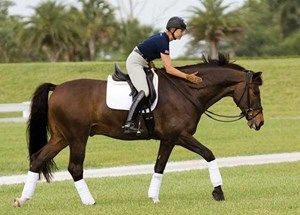
While walking back, it is very useful to repeat stretching exercises, as well as relaxation exercises. This will relax the horse both physically and mentally.
End the session by riding a long rein for a few minutes. In hot weather, it is useful to walk a little longer. If the weather is cool, take care that the horse does not get hypothermia and does not catch a cold.
Post workout routines
During training, the muscles of the horse generate heat (the more intense the training, the more heat accumulates in his body). If the weather is cold, the horse loses excess heat easily, but if it is hot or humid outside, the horse may take a long time to cool down. Watch her breathing – it’s a great indicator of heat stress. If the horse breathes quickly and shallowly, he is trying to get rid of excess heat. In this case, you will need to help her. You can pour water over the horse, drive off excess moisture and walk with it in your hands, and then repeat the procedure. And so on until breathing is restored. It used to be thought that cold water after a workout could cause negative effects, but now we know that this is not the case. And this is the most effective way to cool the horse down. After strenuous jumping or cantering training, it is also worth pouring over the body and lower limbs of the horse to cool the animal and the tendons of its legs.

Passive stretching exercises can only be performed if the horse is still warm. The most useful are those that involve the hips, shoulders, neck and back, especially stretching the hips.
Hilary Clayton; translation by Valeria Smirnova (source)




